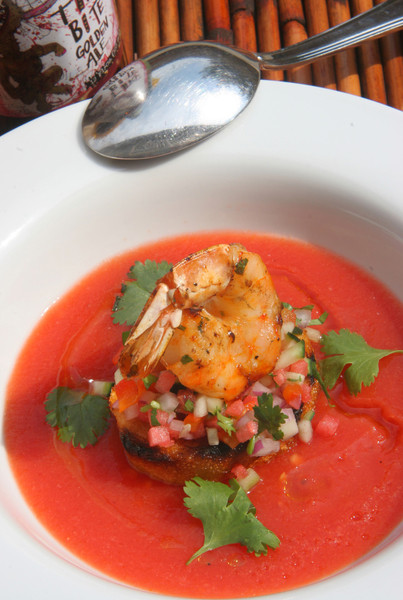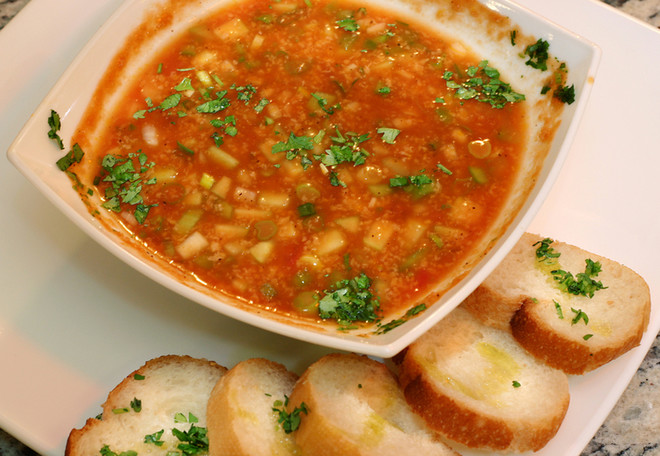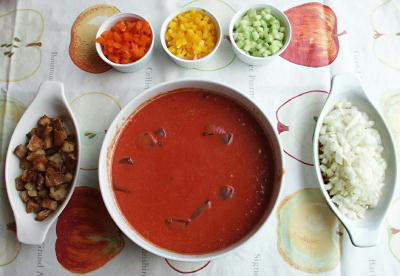 How to cook gazpacho
How to cook gazpacho Today many chefs call gazpachonot only the traditional Spanish tomato soup (we will mention the traditionality of which in gazpacho later), but also any other cold soup made from raw or not requiring cooking products. In fact, the primordial gazpacho has a very distant relationship to all modern variations under the "brand" gazpacho. And tomatoes appeared on Spanish soil only after Columbus discovered America. Gazpacho appeared much earlier and consisted of a mixture of stale bread, garlic, olive oil, salt, etc. Combining salt with garlic and vinegar prevented the body from quickly wasting its water supply, and bread and olive oil filled it with calories. One of the varieties of gazpacho is ahoblanko, or "white gazpacho." By the way, also invented in Andalusia. Pounded and diluted almonds were added to the main ingredients. In the modern version of ajoblanco, you can often find grapes, cucumbers, pieces of apples and even fried anchovies. Before the Spanish got acquainted with tomatoes, along with the white version, a green version of gazpacho was also invented. Green gazpacho, as you might guess, consisted of herbs that could only be found and eaten. It is believed that the first to come up with this option were the inhabitants of Huelva and Sierra Morena. Modern green gazpacho can be anything that is green, not just herbs. With the discovery of tomatoes, the Spanish national dish began a new life. The Spaniards have learned empirically that tomato is an excellent vegetable for making cold soups. It gives a large amount of liquid, has a pleasant sweet and sour taste and an incomparable aroma. A real Spaniard, preparing a classic gazpacho, will never put tomato paste in it, as the same Americans can sin. Only fresh ripe red tomatoes! In addition, the Spaniards do not welcome any peppers in such gazpacho. All that is allowed to be in real gazpacho, except for tomatoes, is olive oil, preferably produced in Spain itself, wine vinegar of the best quality (preferably sherry), garlic, sea salt, and possibly even ground cumin (it is added in some regions of Spain). And that's it! As you can see, nothing is even said about ice cubes for more cooling. In general, the wise Spaniards believe (and they are absolutely right) that a cool liquid refreshes much better than a very cold one.
Today many chefs call gazpachonot only the traditional Spanish tomato soup (we will mention the traditionality of which in gazpacho later), but also any other cold soup made from raw or not requiring cooking products. In fact, the primordial gazpacho has a very distant relationship to all modern variations under the "brand" gazpacho. And tomatoes appeared on Spanish soil only after Columbus discovered America. Gazpacho appeared much earlier and consisted of a mixture of stale bread, garlic, olive oil, salt, etc. Combining salt with garlic and vinegar prevented the body from quickly wasting its water supply, and bread and olive oil filled it with calories. One of the varieties of gazpacho is ahoblanko, or "white gazpacho." By the way, also invented in Andalusia. Pounded and diluted almonds were added to the main ingredients. In the modern version of ajoblanco, you can often find grapes, cucumbers, pieces of apples and even fried anchovies. Before the Spanish got acquainted with tomatoes, along with the white version, a green version of gazpacho was also invented. Green gazpacho, as you might guess, consisted of herbs that could only be found and eaten. It is believed that the first to come up with this option were the inhabitants of Huelva and Sierra Morena. Modern green gazpacho can be anything that is green, not just herbs. With the discovery of tomatoes, the Spanish national dish began a new life. The Spaniards have learned empirically that tomato is an excellent vegetable for making cold soups. It gives a large amount of liquid, has a pleasant sweet and sour taste and an incomparable aroma. A real Spaniard, preparing a classic gazpacho, will never put tomato paste in it, as the same Americans can sin. Only fresh ripe red tomatoes! In addition, the Spaniards do not welcome any peppers in such gazpacho. All that is allowed to be in real gazpacho, except for tomatoes, is olive oil, preferably produced in Spain itself, wine vinegar of the best quality (preferably sherry), garlic, sea salt, and possibly even ground cumin (it is added in some regions of Spain). And that's it! As you can see, nothing is even said about ice cubes for more cooling. In general, the wise Spaniards believe (and they are absolutely right) that a cool liquid refreshes much better than a very cold one.

 Another reason to think before you put ingazpacho ice is the very structure of the soup, which is achieved not by simple mechanical mixing of the ingredients, but by the painstaking combination of oil and liquids. After all, it’s not for nothing that all recipes repeat: “with a slow stream” or “drop by drop” “pour in with constant stirring” ... All this is done in order to get a pleasant homogeneous, almost satin structure of the soup! .. nothing but puddles of water, unappetizingly spilled on the surface. However, if you really want to add ice or the same pepper or something else to Gazpacho, not a single Spaniard will, of course, catch you by the hand. Moreover, they themselves are not averse to trying new tastes from time to time in the old dish. However, these are not all kinds of gazpacho that Andalusians enjoy. There is another soup, very similar to tomato gazpacho, but, nevertheless, significantly different from it. It is salmorejo or ardoria, as it is also called in Andalusia. It owes its origin to Cordoba, the province of Andalusia, and it is based on tomatoes, bread, olive oil, garlic and vinegar. A familiar combination of ingredients, isn't it? For salmorejo, tomatoes are freed from the skin and are mashed with all of the ingredients listed, and at the end of cooking, chopped ham (Spanish Serono ham, of course!) And hard boiled eggs are added to the soup. Salmorekho is thicker in structure than tomato gazpacho because of its high content of bread.Salmorekho is in Sevilsky Ingredients: 450 g ripe tomatoes, 1 clove of garlic, 50 g of white stale bread, 1-2 tbsp. balsamic vinegar, olive oil, sea salt, black ground pepper. For garnish: ham slices, hard-boiled eggs Preparation: Remove peel from tomatoes, chop the pulp into pieces, mash in garlic, add vinegar, salt and pepper. Then add to the mass half the amount of bread, mix until smooth. The remaining bread, continue to add in small portions along with olive oil, without stopping the mixing process. When the soup has a smooth creamy texture, put it in the fridge for a while. Before serving, add ham and chopped eggs to the soup. Serve fresh white bread for the soup. Gazpacho will probably never stop its evolutionary path. Today, we owe a huge number of variants of this dish to the cooks of elite restaurants who, for the sake of Michelin stars, go on such unexpected experiments, as a result of which watermelon, cherry, mango and other gazpacho are born.
Another reason to think before you put ingazpacho ice is the very structure of the soup, which is achieved not by simple mechanical mixing of the ingredients, but by the painstaking combination of oil and liquids. After all, it’s not for nothing that all recipes repeat: “with a slow stream” or “drop by drop” “pour in with constant stirring” ... All this is done in order to get a pleasant homogeneous, almost satin structure of the soup! .. nothing but puddles of water, unappetizingly spilled on the surface. However, if you really want to add ice or the same pepper or something else to Gazpacho, not a single Spaniard will, of course, catch you by the hand. Moreover, they themselves are not averse to trying new tastes from time to time in the old dish. However, these are not all kinds of gazpacho that Andalusians enjoy. There is another soup, very similar to tomato gazpacho, but, nevertheless, significantly different from it. It is salmorejo or ardoria, as it is also called in Andalusia. It owes its origin to Cordoba, the province of Andalusia, and it is based on tomatoes, bread, olive oil, garlic and vinegar. A familiar combination of ingredients, isn't it? For salmorejo, tomatoes are freed from the skin and are mashed with all of the ingredients listed, and at the end of cooking, chopped ham (Spanish Serono ham, of course!) And hard boiled eggs are added to the soup. Salmorekho is thicker in structure than tomato gazpacho because of its high content of bread.Salmorekho is in Sevilsky Ingredients: 450 g ripe tomatoes, 1 clove of garlic, 50 g of white stale bread, 1-2 tbsp. balsamic vinegar, olive oil, sea salt, black ground pepper. For garnish: ham slices, hard-boiled eggs Preparation: Remove peel from tomatoes, chop the pulp into pieces, mash in garlic, add vinegar, salt and pepper. Then add to the mass half the amount of bread, mix until smooth. The remaining bread, continue to add in small portions along with olive oil, without stopping the mixing process. When the soup has a smooth creamy texture, put it in the fridge for a while. Before serving, add ham and chopped eggs to the soup. Serve fresh white bread for the soup. Gazpacho will probably never stop its evolutionary path. Today, we owe a huge number of variants of this dish to the cooks of elite restaurants who, for the sake of Michelin stars, go on such unexpected experiments, as a result of which watermelon, cherry, mango and other gazpacho are born.

Making Money with Desserts: Success Stories
Yevhen Polishchuk (Fedutinov) instagram: @ evgeniyafedutinovavk.com / janeshomebaking– It all started with baking for relatives and friends. Gradually, she began uploading photos of her baking to Instagram, and orders began to come in. I made my first cake to order on October 13, 2014, and a little earlier I started making macarons and cupcakes. We can say that the business "found me myself", I am very [...]

Soups are cold recipes with photos
Cold cucumber soup with yogurt and lemonSorbet from La Taverna restaurant chef Alexander Zhurkina Photo: Getty Images Ingredients: Yoghurt without additives - 125 gCucumber - 150 gSorbet lemon / lime - 50 gCool shrimp - 24 gFresh ginger - 1 gLime lime - 5 gFresh orange juice - 5 gPetroshka - 1 g pink - 1 gCress salad - […]

barbeque kebab
Pork tenderloin glaze Photos: Dmitry Bayrak / dbstudio Cooking time: 20 minutes + time for pickling. Calorie content: 454 kcal per 1 serving. For 4 servings: 4 pork tenderloin (about 300 g each), 1 onion, 2 cloves of garlic, 1 tsp. lemon peel, 1 tsp. lemon juice, a pinch of ground cumin, coriander and turmeric, 1 tbsp. l vegetable [...]

Pierre Duacan: dietary recipes: Ducane diet
Beetroot Photo: Season'S, Luxury Hotels Representation You will need: · Boiled beets - 60 g · Fresh cucumbers - 20 g · Red radish - 20 g · Green onions - 10 g · Egg - 1 pcs · Mineral drinking water - 200 g · Salt - 1 g Ready: · Boil egg and beetroot. · Grind cucumbers, radishes and a part of beets. Putting everything [...]





